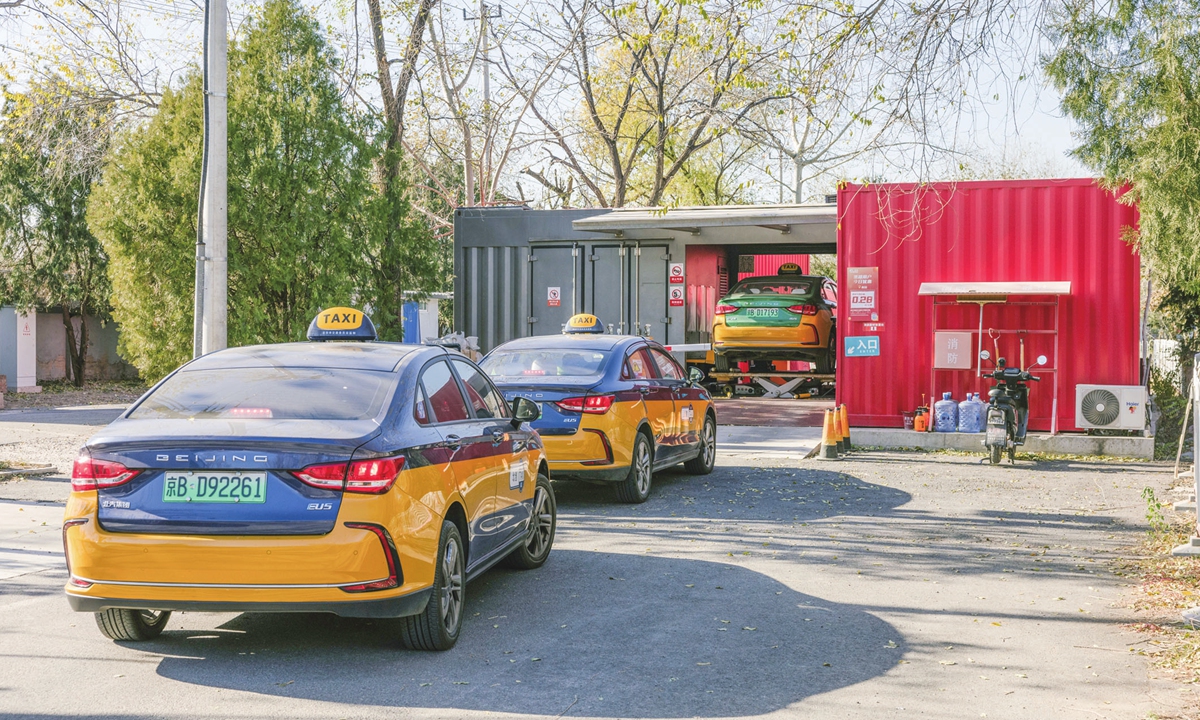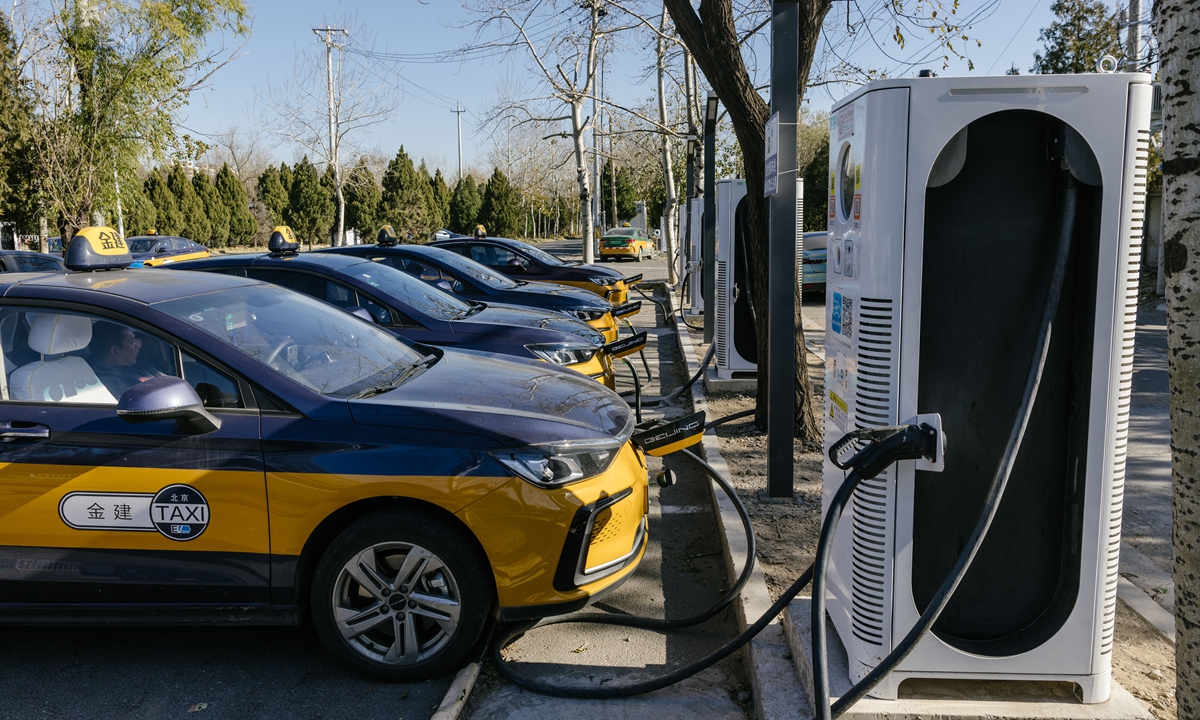
City view of Beijing Photo: VCG
Beijing's taxi drivers are a distinguished part of the capital city's rich tapestry. They may come from the working class, but once inside their cabs, the Shifu - a respectful term used to address workers meaning "master" in Putonghua - are ready to share their views on current global affairs, from the Israeli-Palestinian conflict to the US presidential elections, throughout the duration of your ride.
This group, with a literal and figurative front row seat to the changing times, is now leading another trend in China - a grassroots-level, society-wide green campaign.
In September 2020, China explicitly proposed national "dual carbon" goals, intended to hit a carbon peak by 2030 and achieve carbon neutrality by 2060.
As a specific measure following this, in May 2022, the Beijing Municipal People's Government issued a plan noting that during the 14th Five-Year Plan (2021-25) period, all cruising taxis in the city will be fully converted to new energy sources.
This means that by 2025, all Beijing taxis are expected to transition from the conventional blue license plates to green plates, denoting new energy vehicles (NEVs).
Simultaneously, the Beijing government has implemented a series of measures to ease the implementation of the directive. This transition does not happen overnight. For taxi operators, it is a process of adaptation.
Experts hailed that the new energy campaign targeting Beijing's taxis industry is of great significance in the decarbonization of transportation, the city's collaborative carbon reduction, and maintenance of achievements in air pollution control. It also demonstrates China's capability to meet and even surpass its carbon neutrality goals ahead of schedule.
The 28th Conference of the Parties (COP28) to the UN Framework Convention on Climate Change will be held in Dubai, United Arab Emirates, from November 30 to December 12. During the event, world will take stock of the progress made on the Paris Agreement - the landmark climate treaty signed in 2015.
The global community is keenly watching whether China will update its Nationally Determined Contribution (NDC) targets and intensify its emission reduction efforts. Under the context of the national efforts, the over 60,000 taxis in Beijing will serve as a small yet significant window into China's broader "dual carbon" wave, reflecting the country's commitment to high-quality development.
Adaptation to new rhythmIn the bustling heart of Beijing, amid the clamor and ceaseless motion, taxi driver Wang Aihua is a moving witness to a silent campaign.
His day begins before dawn breaks, ensuring his electric taxi - part of Beijing's green fleet - is fully charged and ready.
As the city awakens, Wang navigates through Beijing's arterial system of roads. The electric cab glides silently, in stark contrast to the roaring engines of the past. "It is way cleaner," Wang told the Global Times. "No fumes and no oil splatters. It is the future."
Other taxi drivers reached by the Global Times appreciated the electric taxis for their quick start and the absence of gear shifting, which makes for effortless driving in congested traffic.
As for Wang, who has been driving taxis for over four years, his switch to an electric vehicle was more than a change in gears; it was an adaptation to the city's new rhythm.
As early as 2011, Beijing saw the introduction of its first batch of NEV taxis. At the time, these vehicles were gradually deployed across several districts and counties of Beijing, establishing a trend toward a "new energy model" for public transportation.
Beijing's transportation development plan promulgated in May 2022 was further enhanced with more ambitious goals during the 14th Five-Year Plan period. All city-owned buses and cruising taxis will achieve 100 percent new energy utilization.
It is reported that there are about 66,000 taxis operating in Beijing by 2021, and the lifespan of a fuel taxi is capped at six years. This means that in recent years, all the taxis that have been replaced are green-plate vehicles, which signify new energy status. "In a taxi company, you can hardly see any fuel-powered cars now," Wang said.
Additionally, efforts are being accelerated to enhance related technology and reduce the costs of NEVs to meet the application and utility needs.
Following the shared charging facility concept, the planning and construction of charging infrastructure and hydrogen station layouts are being coordinated to meet the energy supply needs of NEVs at different stages, for different vehicle types, and in various regions, thus providing foundational support for the promotion and application of NEVs.
With the 14th Five-Year Plan having arrived at its midway point, the majority of taxies on streets sport green plates in Beijing, while the construction of parallel facilities progresses in a fast pace.

Taxis queue to swap batteries at a battery station in Xiaotun, Fengtai district in southern Beijing on November 24, 2023. Photo: Li Hao/GT
In the Xiaotun area of Fengtai district, southern Beijing, the Global Times noted that a taxi battery swap station experiences a steady flow of customers.
Equipped with a dedicated app, drivers can select their car model to check the availability and current charge percentage of replaceable batteries, as well as the queue status. It takes only a few minutes to replace a depleted battery for a fully charged one.
Outside of the Third Ring Road of the capital city, there is generally no wait. Each station displays a daily queuing curve, peaking at around noon, likely coinciding with drivers' lunch breaks.
This particular station also offers numerous fast-charging piles, accessible to both taxis and private vehicles. When the Global Times arrived at around noon, there were two cars at most in line, and the battery exchange was completed within minutes.
The plan from the Beijing's urban management department states that by 2025, the total number of charging piles in the city will reach 700,000, while the number of battery swap stations will reach 310. The average service radius of public charging facilities for electric vehicles in plain areas is less than 3 kilometers.
Challenges under anticipationElectric taxis have contributed to Beijing's blue skies and have reaped rewards in the fiercely competitive taxi market. Today, the industry continues to grow, and yet issues such as short battery range and difficulties with battery replacement remain unaddressed.
The electric transition has not been without its hurdles. Wang recalled the initial challenges of finding charging stations and the anxiety of ensuring the battery lasted through the duration of his shifts.
"It is like the early days of gasoline cars," he mused. "You plan your route and your day around the life of the battery."
Wang's concerns are not unfounded. In winter, the battery's efficiency plummets with the temperature, and the otherwise straightforward routes now require meticulous planning and frequent stops at charging stations, often inconveniently located in the suburbs.
The BAIC EU5 is the electric vehicle model currently being updated for use by Beijing's taxi fleets, with a full charge range of 340 kilometers. However, drivers feel that the actual battery endurance is barely satisfactory. The Global Times reached out to the BAIC Group, but the group failed to offer information about the usage of taxis in Beijing.
"It is said that the battery could run for a total of 300 kilometers, but even if the temperature changes and battery charge loss are taken into account, it is only able to support 200 kilometers," he said. "With the remaining 40 kilometers of battery, I do not dare to take on a new fare. I have to quickly find a battery station to replace the battery. Sometimes we have to drag passengers along to change the battery."

Some taxis are charging their batteries at a battery station in Fengtai district, Beijing on November 24, 2023. Photo: Li Hao/GT
"The battery often cannot service a return trip to Daxing Airport!" he complained. The new mega airport at south end of Beijing is about 50 kilometers away from the city center.
Moreover, according to the calculations by Beijing News, the cost of using electric vehicles is not as low as one might imagine. Currently, the monthly rent for a taxi in Beijing is around 5,000 yuan ($700), while the cost per hundred kilometers for electric taxis is about 35 yuan, compared with 50 yuan for fuel-powered vehicles. Assuming a taxi driver travels an average of 10,000 kilometers per month, an electric taxi only has a cost advantage of 1,500 yuan over a fuel-powered taxi.
'We are pioneers'As Beijing navigates through these changes, the city's commitment to a sustainable and high-quality development pathway is evident. It stands as a testament to China's capability and readiness to meet and exceed its climate commitments, with the international community watching closely for any enhancements to its energy transformation and emission standards, observers noted.
Ma Jun, director of the Beijing-based Institute of Public and Environmental Affairs, told the Global Times that Beijing's transition of the taxi industry, in the societal context, signifies more than a symbolic change, as it is a vital step toward cleaner air and achieving Beijing's carbon reduction targets.
Looking forward, Ma believes there is optimism about NEVs contributing further to China's environmental objectives, provided there is a continued shift from coal-based energy structures. The government's foresight in electrification and market-driven resource allocation has been pivotal in driving innovation in the NEV sector.
Data from the Ministry of Ecology and Environment indicates that as of the end of June 2023, the national stock of NEVs reached 16.2 million units, accounting for 4.9 percent of the total number of vehicles. In the first half of the year, 3.128 million NEVs were newly registered, a year-on-year increase of 41.6 percent.
In 2022, NEV production and sales reached 7.058 million and 6.887 million units, representing year-on-year increases of 96.9 percent and 93.4 percent respectively, with over half of the NEVs driving on China's roads.
This influence is also radiating to other countries. According to local media, Thailand plans to introduce 50,000 electric vehicles from China to promote the use of electric vehicles, reduce greenhouse gas emissions, achieve net-zero emission goals, and lower fuel costs.
Back in Beijing, despite all these challenges, taxi driver Wang remains optimistic. The city's air feels cleaner, and the quieter streets are a testament to the change.
"We are pioneers," he says with a grin. "This is our contribution to the environment."






